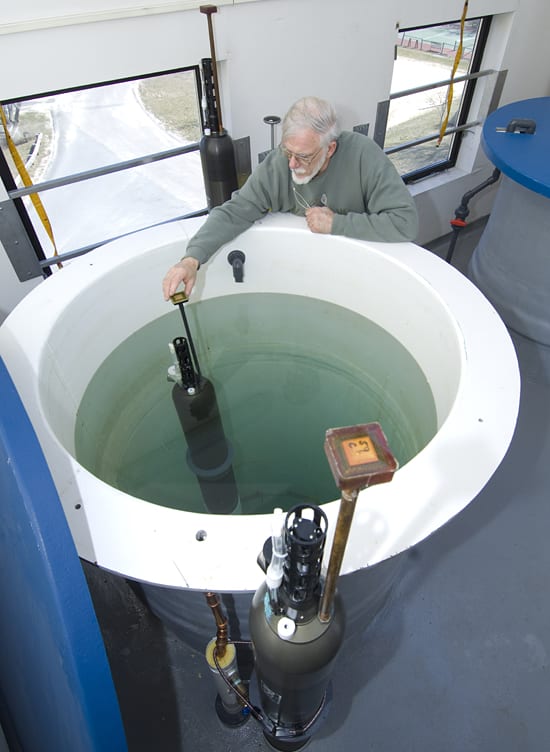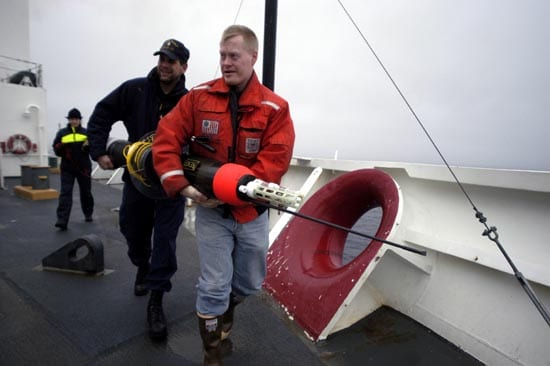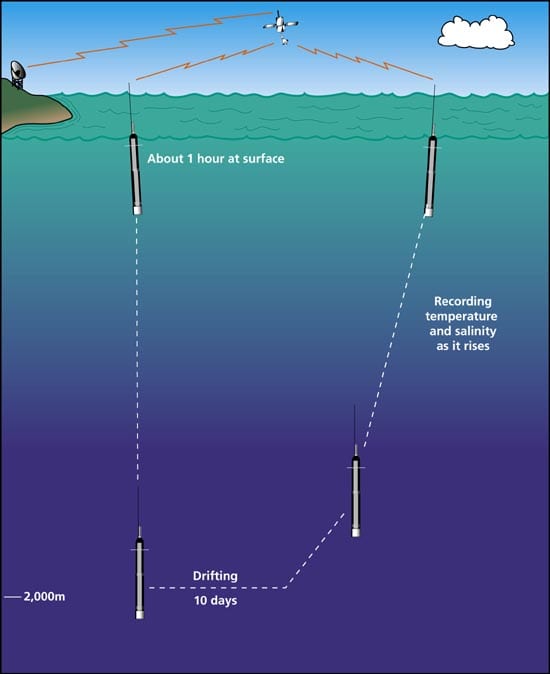ALACE, PALACE and SOLO Floats
What are they and why do we use them?
ALACE, PALACE and SOLO floats are drifting instruments that measure ocean temperature and salinity. After they are deployed, they move with the ocean currents and can, therefore, travel long distances on their own without the need of a ship or a person to handle them. Floats are programmed to come to the ocean surface at regular intervals to transmit their data and position to orbiting satellites. Afterward, they continue measuring ocean conditions, with at-sea missions lasting 4-5 years. This provides oceanographers with a wealth of real-time data from often-remote regions of the world’s oceans.
These three types of floats form the backbone of the international Argo program. The goal of the Argo float program is to have 3,000 floats at work throughout the world's oceans by the end of 2006. Argo floats collect the oceanographic data necessary to understand the processes that influence our global climate.
How do they work?
The floats have the ability to change their own buoyancy; and, when they are deployed, they sink to a pre-specified depth (typically 2,000 meters). They usually remain at this depth for 7-10 days, drifting with the ocean currents. The float will then rise to the ocean surface, where it communicates its data and position to an orbiting satellite. The float then sinks again, continuing the process.
To control the buoyancy of the float, a small amount of oil is contained within the float. When the float is submerged, all of the oil is kept entirely within the hull. When it is time to rise to the surface, the oil is pumped into an external rubber bladder that expands. Since the weight of the float does not change but its volume increases when the bladder expands, the float becomes more buoyant and floats to the surface. Similarly, when the float is on the surface and it is time to submerge, the oil is withdrawn from the bladder into the hull of the float and the buoyancy decreases.
Because PALACE and SOLO floats acquire the same data as that from a Conductivity-Temperature-Depth (CTD) sensor, these floats are sometimes referred to as “floating CTDs.” Over the course of their mission, PALACE and SOLO floats can acquire measurements that are the equivalent of more than 100 CTD profiles.
What's the difference between the three floats?
ALACE, PALACE and SOLO floats are closely related to each other. ALACE floats take ocean measurements of temperature when they are floating at depth. PALACE and SOLO floats can measure temperature plus salinity (conductivity) and pressure (depth), and take these measurements as they rise to the surface. SOLO floats are very similar to PALACE floats, but have better satellite communication and acoustic tracking capabilities.
What does it take to get them in the water?
Because the floats (body plus antenna) are only about 6 feet long and 80 lbs in weight, they can be deployed from any ship by one or two people without special equipment. Typically, the instruments are lowered over the side of the ship simply with a rope. In high seas, the floats can be deployed in biodegradable boxes that protect the instrumentation from rough landings. Once a float is deployed, neither ships nor people are required to obtain the measurements.
Advantages
Floats are easy to deploy, they can conduct long-lived missions and they acquire and communicate data to researchers throughout the world without the direct involvement of ships or people.
Limitations
Data sets recorded by floats can contain small gaps. ALACE floats do not acquire data when they are descending or ascending, and this results in a data gap, especially when strong currents push the float a significant distance during ascent or descent. Similarly, PALACE and SOLO floats do not acquire data when they are descending or floating at depth, so a similar gap in data can result.
Sources
The scientists of the WHOI Physical Oceanography Department Float Group.
NOAA. 1998. Preliminary report on PALACE floats. NOAA Atlantic Oceanographic and Meteorological Laboratory, Miami, FL.
WHOI. 2000. Argo: A Global Array of Profiling Floats. Woods Hole Oceanographic Institution, Woods Hole, MA. (see link at right)
(Photo by Tom Kleindinst, Woods Hole Oceanographic Institution)
See Also
Oceanus magazine feature story
Under-Ice Floats Offer a 'Breakthrough'
By modifying SOLO floats, researchers are learning about water hidden under arctic ice. From Oceanus magazine.



